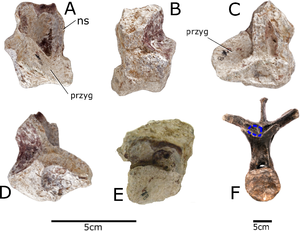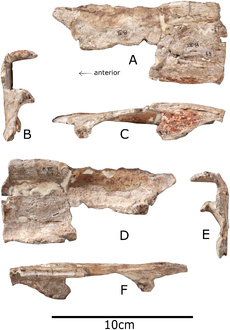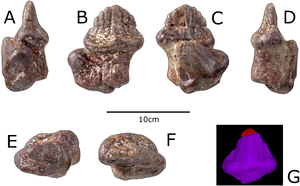پارانثودون
| پارانثودون | |
|---|---|

| |
| إعادة بناء الجمجمة؛ المادة الرمادية غير معروفة. | |
| التصنيف العلمي | |
| أصنوفة غير معروفة (أصلحها): | Paranthodon |
| Species: | Template:Taxonomy/ParanthodonP. africanus
|
| Binomial name | |
| Template:Taxonomy/ParanthodonParanthodon africanus | |
| Synonyms[4] | |
پارانثودون (Paranthodon ؛ /pəˈrænθədɒn/؛ pə-RAN-thə-don[5]) هو جنس ديناصورات ستگاصورية عاشت في جنوب أفريقيا أثناء العصر الطباشيري المبكر، بين 139 و 131 مليون سنة مضت. اِكتُشِف في 1845، فكان واحداً من أوائل الستگاصوريات المكتشفة. بقاياه الوحيدة، جمجمة جزئية، أسنان منعزلة، وشظايا من فقرات، عـُثـِر عليهم في تكوين كيركوود. تعرَّف مبدئياً عالم الإحاثة البريطاني رتشارد أوِن على الشظايا بأنها تعود إلى الأنثودون pareiasaur. وبعد أن بقي لا يمسه أحد لسنوات في متحف التاريخ الطبيعي البريطاني، تعرَّف عالم الإحاثة الجنوب أفريقي روبرت بروم على الجمجمة الجزئية بأنها تعود إلى جنس مختلف؛ فسمَّى العينة Palaeoscincus africanus. وبعد سنوات عدة، استنتج بشكل مشابه عالم الإحاثة المجري فرنتس نوپچا، دون علم بالإسم الجديد الذي اختاره بروم، أنه يمثل أصنوفة جديدة، وسماها Paranthodon owenii. ولما كان اسم نوع نوپچا قد صيغ بعد بروم، ولم يخصص بروم جنساً جديداً، فإن كلا الإسمين هما الآن مترادفان للاسم الثنائي الحالي، Paranthodon africanus. اسم الجنس يجمع اليونانية القديمة para (قرب) مع اسم الجنس Anthodon، ليمثل الإشارة الأولية للبقايا.
In identifying the remains as those of Palaeoscincus, Broom initially classified Paranthodon as an ankylosaurian, a statement backed by the research of Coombs in the 1970s. However, in 1929, Nopcsa identified the taxon as a stegosaurid, with which most modern studies agree. In 1981, the genus was reviewed with modern taxonomy, and found to be a valid genus of stegosaurid. However, a 2018 review of Paranthodon could only identify one distinguishing feature, and while that study still referred it to Stegosauria based on similarity and multiple phylogenetic analyses, no diagnostic features of the group could be identified in Paranthodon.
تاريخ الاكتشاف

المادة
الوصف

Thirteen teeth are preserved in Paranthodon, but as they extend to the back of the maxilla there were possibly more in life. The teeth are symmetrical as in stegosaurs except Chungkingosaurus. Along the base of the tooth crown there is a swelling (cingulum), which is seem in all other stegosaurs teeth are known from except Huayangosaurus.[4] The teeth have a middle ridge, with five fewer prominent ridges on either side. This is similar to the size ridges seen on Kentrosaurus.[6] Like all stegosaurians, the denticles on the teeth are rounded at the tips, in contrast to ankylosaurians. Also, like Huayangosaurus, but unlike Kentrosaurus and Stegosaurus, Paranthodon possesses a prominent buccal margination (a ridge beside the tooth row). Paranthodon teeth preserve wear, but wear is absent on most teeth, similar to Huayangosaurus, meaning it is likely that Paranthodon lacked occlusion between teeth.[7]
التبويب
Currently, Paranthodon is classified as a stegosaur related to Stegosaurus, Tuojiangosaurus, and Loricatosaurus. Initially, when Broom assigned the name Palaeoscincus africanus to the Paranthodon fossils, he classified them as an ankylosaurian. This classification was later changed by Nopcsa, who found that Paranthodon best resembled a stegosaurid (before the group was truly defined[8]). Coombs (1978) did not follow Nopcsa's classification, keeping Paranthodon as an ankylosaurian, like Broom, although he only classified it as Ankylosauria incertae sedis.[9] A subsequent review by Galton and Coombs in 1981 instead confirmed Nopcsa's interpretation, redescribing Paranthodon as a stegosaurid from the Late Cretaceous.[10][6] Paranthodon was distinguished from other stegosaurs by a long, wide, posterior process of the premaxilla, teeth in the maxilla with a very large cingulum, and large ridges on the tooth crowns.[11] Not all of these features were considered valid in a 2008 review of Stegosauria, with the only autapomorphy found being the possession of a partial second bony palate on the maxilla.[12]
Multiple phylogenetic analyses have placed Paranthodon in Stegosauria, and often in Stegosauridae. A 2010 analysis including nearly all species of stegosaurians found that Paranthodon was outside Stegosauridae, and in a polytomy with Tuojiangosaurus, Huayangosaurus, Chungkingosaurus, Jiangjunosaurus, and Gigantspinosaurus. However, when the latter two genera were removed, Paranthodon grouped with Tuojiangosaurus just outside Stegosauridae, and Huayangosaurus grouped with Chungkingosaurus in Huayangosauridae.[13] An elaboration upon this analysis was published in 2017 by Susannah Maidment and Thomas Raven, and it resolved relationships within Stegosauria much more. All taxa were remained included, and Paranthodon grouped with Tuojiangosaurus, Huayangosaurus and Chunkingosaurus as the most basal true stegosaurians. However, the position of Alcovasaurus was uncertain, and further work could change the result. Below is the analysis.[14]

| Thyreophora |
| ||||||||||||||||||||||||||||||||||||||||||||||||||||||||||||||||||||||||||||||||||||||||||||||||||||||||||||||||||||||||||||||
Other analyses have found Paranthodon closely related to Tuojiangosaurus, Loricatosaurus, and Kentrosaurus within Stegosaurinae.[12][15] Even though phylogenetic analyses recognize Paranthodon as a stegosaurid, the type material actually bears no synapomorphies of Stegosauria. However, the material is likely of stegosaurian nature, and phylogenies by many authors have found it to be within the group.[13]
علم الإحاثة
The Kirkwood Formation is in South Africa, and many fossils of different species and genera have been discovered in it, with Paranthodon being the first uncovered.[16] The formation is of a Late Jurassic to Early Cretaceous age, with the oldest deposits from the Tithonian, about 145.5 million years ago, and the youngest rocks being from the Valanginian, about 130 million years ago.[5][11][17] The specific vertebrate-bearing portion of the formation is approximately level with the upper region of the Sundays River Formation, which has been dated to 139 to 131 mya based on microfossils.[18] A large variety of different animal groups have been found in the formation, including dinosaurs, at least two different sphenodontian lizards, multiple teleost fishes, a few crocodylians, some frog specimens, and also turtles. However, a large amount of the material of the Kirkwood formation only includes isolated teeth or partial and fragmentary pieces of bone. Dinosaurs of the formation include a basal tetanuran, the primitive ornithomimosaurian Nqwebasaurus, the sauropod Algoasaurus, a potential titanosaurian, many ornithischians including Paranthodon, a genus of iguanodontian, and a "hypsilophodontid" (the family Hypsilophodontidae is no longer considered to be a natural grouping[19]).[16][20] Multiple additional sauropod taxa have been discovered, including a basal eusauropod, a brachiosaurid, a dicraeosaurid and a derived diplodocid.[18]
References
- ^ أ ب Broom, R. (1912). "Observations on some specimens of South African fossil reptiles preserved in the British Museum". Transactions of the Royal Society of South Africa. 2: 19–25. doi:10.1080/00359191009519357.
- ^ أ ب Nopsca, F. (1929). "Dinosaurierreste aus Siebenburgen V. Geologica Hungarica. Series Palaeontologica". Fasciculus. 4 (1): 13.
- ^ Owen, R. (1876). "Descriptive and illustrated catalogue of the fossil Reptilia of South Africa in the collection of the British Museum". Order of the Trustees: 14–15.
- ^ أ ب خطأ استشهاد: وسم
<ref>غير صحيح؛ لا نص تم توفيره للمراجع المسماةraven2018 - ^ أ ب Holtz, T.R. Jr. (2007). Dinosaurs: The Most Complete, Up-to-Date Encyclopedia for Dinosaur Lovers of All Ages. Random House Books. p. 402. ISBN 978-0-375-92419-4.
- ^ أ ب Galton, P.M. (1981). "Craterosaurus pottonensis Seeley, a stegosaurian dinosaur from the Lower Cretaceous of England, and a review of Cretaceous stegosaurs". Neues Jahrbuch für Geologie und Paläontologie. 161 (1): 28–46. ISSN 0077-7749.
- ^ Barrett, P.M. (2001). "Tooth Wear and Possible Jaw Action of Scelidosaurus harrisonii Owen and a Review of Feeding Mechanisms of Other Thyreophoran Dinosaurs". In Carpenter, Kenneth (ed.). The Armoured Dinosaurs. Indiana University Press. pp. 36–39. ISBN 978-0-253-33964-5.
- ^ Sereno, P.C. (2005). "Stegosauridae". TaxonSearch: Database for Suprageneric Taxa & Phylogenetic Definitions. Archived from the original on 2015-07-01. Retrieved 2014-10-02.
{{cite web}}: Unknown parameter|deadurl=ignored (|url-status=suggested) (help) - ^ Coombs, W.P. Jr. (1978). "The Families of the Ornithischian Dinosaur Order Ankylosauria" (PDF). Palaeontology. 21 (1): 143–170. Archived from the original (PDF) on 2015-07-08. Retrieved 2017-01-03.
{{cite journal}}: Unknown parameter|dead-url=ignored (|url-status=suggested) (help) - ^ Galton, P.M.; Coombs, W.P. Jr. (1981). "Paranthodon africanus (broom) a stegosaurian dinosaur from the Lower Cretaceous of South Africa". Geobios. 14 (3): 299–309. doi:10.1016/S0016-6995(81)80177-5.
- ^ أ ب Glut, D.F. (1997). Dinosaurs, the encyclopedia. McFarland & Co. pp. 676–677. ISBN 978-0-7864-7222-2.
- ^ أ ب Maidment, S.C.R.; Norman, D.B.; Barrett, P.M.; Upchurch, P. (2008). "Systematics and Phylogeny of Stegosauria (Dinosauria: Ornithischia)". Journal of Systematic Palaeontology. 6 (4): 367–407. doi:10.1017/S1477201908002459.
- ^ أ ب Maidment, S.C.R. (2010). "Stegosauria: a historical review of the body fossil record and phylogenetic relationships". Swiss Journal of Geological Sciences. 103 (2): 199–210. doi:10.1007/s00015-010-0023-3. ISSN 1661-8726.
- ^ Raven, T.j.; Maidment, S.C.R. (2017). "A new phylogeny of Stegosauria (Dinosauria, Ornithischia)" (PDF). Palaeontology. 2017 (3): 1–8. doi:10.1111/pala.12291. Archived from the original (Submitted manuscript) on 2018-08-19. Retrieved 2018-08-06.
{{cite journal}}: Unknown parameter|dead-url=ignored (|url-status=suggested) (help) - ^ Galton, P.M. (2012). "Stegosauria". In Brett-Surman, Michael; Holtz, Thomas R. Jr.; Farlow, James O. (eds.). The Complete Dinosaur. Indiana University Press. p. 486. ISBN 978-0-253-00849-7.
- ^ أ ب Forster, C.A.; Farke, A.A.; McCartney, J.A.; de Klerk, W.J.; Ross, C.F. (2009). "A "Basal" Tetanuran from the Lower Cretaceous Kirkwood Formation of South Africa" (Full text). Journal of Vertebrate Paleontology. 29 (1): 283–285. doi:10.1671/039.029.0101. JSTOR 20491088.
- ^ Pereda Suberbiola, X.; Galton, P.M.; Torcida, F.; Huerta, P.; Izquierdo, L.A.; Montero, D.; Pérez, G.; Urién, V. (2003). "First stegosaurian dinosaur remains from the Early Cretaceous of Burgos (Spain), with a review of Cretaceous stegosaurs". Revista Espanola de Paleontologia. 18 (2): 143–150. ISSN 0213-6937.
- ^ أ ب McPhee, B.W.; Mannion, P.D.; de Klerk, W.J.; Choiniere, J.N. (2016). "High diversity in the sauropod dinosaur fauna of the Lower Cretaceous Kirkwood Formation of South Africa: Implications for the JurassiceCretaceous transition". Cretaceous Research. 59 (2016): 228–248. doi:10.1016/j.cretres.2015.11.006. hdl:10044/1/27470.
- ^ Brown, C. M.; Evans, D. C.; Ryan, M. J.; Russell, A. P. (2013). "New data on the diversity and abundance of small-bodied ornithopods (Dinosauria, Ornithischia) from the Belly River Group (Campanian) of Alberta". Journal of Vertebrate Paleontology. 33 (3): 495. doi:10.1080/02724634.2013.746229.
- ^ Chinsamy, A. (1997). "Albany Museum, Grahamstown, South Africa". In Currie, P.J.; Padian, K. (eds.). Encyclopedia of Dinosaurs. Academic Press. p. 6. ISBN 978-0-12-226810-6.
خطأ استشهاد: الوسم <ref> ذو الاسم "holtzsuplementary" المُعرّف في <references> غير مستخدم في النص السابق.
خطأ استشهاد: الوسم <ref> ذو الاسم "durand" المُعرّف في <references> غير مستخدم في النص السابق.
خطأ استشهاد: الوسم <ref> ذو الاسم "atherstone" المُعرّف في <references> غير مستخدم في النص السابق.
خطأ استشهاد: الوسم <ref> ذو الاسم "olshevsky1978" المُعرّف في <references> غير مستخدم في النص السابق.
خطأ استشهاد: الوسم <ref> ذو الاسم "hall11" المُعرّف في <references> غير مستخدم في النص السابق.



